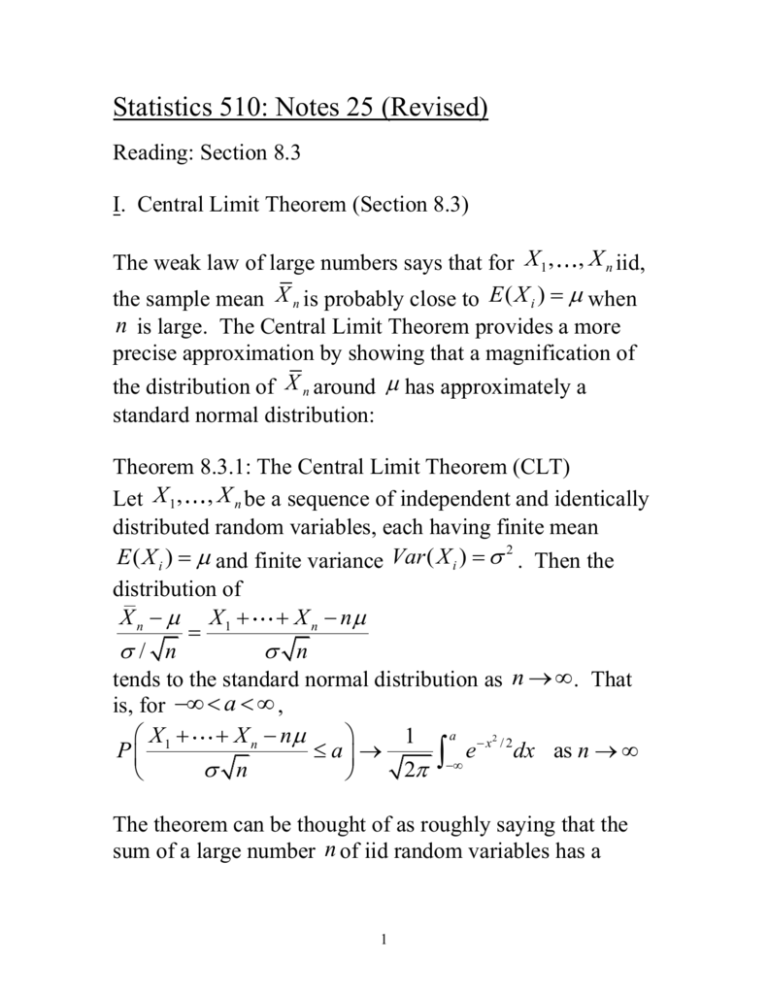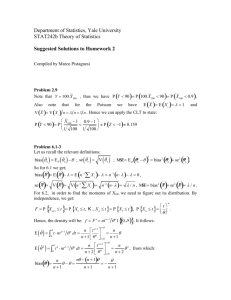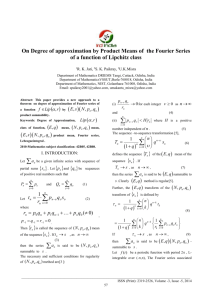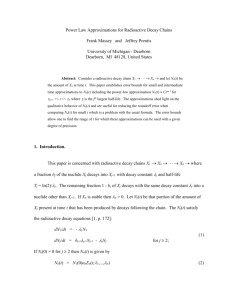Notes 25
advertisement

Statistics 510: Notes 25 (Revised) Reading: Section 8.3 I. Central Limit Theorem (Section 8.3) The weak law of large numbers says that for X 1 , , X n iid, the sample mean X n is probably close to E ( X i ) when n is large. The Central Limit Theorem provides a more precise approximation by showing that a magnification of the distribution of X n around has approximately a standard normal distribution: Theorem 8.3.1: The Central Limit Theorem (CLT) Let X 1 , , X n be a sequence of independent and identically distributed random variables, each having finite mean E ( X i ) and finite variance Var ( X i ) 2 . Then the distribution of X n X 1 X n n / n n tends to the standard normal distribution as n . That is, for a , 1 a x2 / 2 X X n n P 1 a e dx as n n 2 The theorem can be thought of as roughly saying that the sum of a large number n of iid random variables has a 1 distribution that is approximately normal with mean n and variance n 2 . By writing X1 X n 1 X X n 1 n X 1 X n n n n 1 n n n n we see that the CLT says that the sample mean X Xn Xn 1 has a approximately a normal n distribution with mean and variance . n The CLT is a remarkable result – only assuming that a sequence of iid random variables have a finite mean and variance, the central limit theorem shows that the mean of the sequence, suitably standardized, always converges to having a standard normal distribution. Note: The normal approximation to the binomial distribution from Section 5.4.1 is a special case of the central limit theorem. Before examining the proof, we look at a few applications. Example 1: Do you believe a friend who claims to have tossed heads 5,250 times in 10,000 tosses of a fair coin? 2 Example 2: Bill makes 100 check transactions between receiving two consecutive bank statements. Rather than subtract each amount exactly, he rounds each entry off to the nearest dollar. Let X i denote the round-off error associated with the i th transaction [it can be assumed that X i has a uniform distribution over the interval (-0.5,0.5)]. Use the central limit theorm to approximate that Bill’s total accumulated error (either positive or negative) after 100 transactions exceeds $5. 3 4 Proof of the Central Limit Theorem We know from Chapter 7.7 that a distribution function is uniquely determined by its moment generating function. The following lemma states that this unique determination holds for limits as well (see W. Feller, An Introduction to Probability Theory and Its Applications, Volume II, 1971, for the proof) Lemma 8.3.1: Let Z1 , Z 2 , be a sequence of random variables having distribution functions FZ n and moment generating functions M Z n , n 1 ; and let Z be a random variable having distribution function FZ and moment generating function M Z . If M Z n (t ) M Z (t ) for all t, then FZ n (t ) FZ (t ) for all t at which FZ (t ) is continuous. If we let Z be a standard normal random variable, then, as M Z (t ) e t2 / 2 , it follows from Lemma 8.3.1, that if t 2 / 2 as n , then FZn (t ) (t ) as n . The central limit theorem is proved by showing that the moment generating functions of X 1 X n n M Zn (t ) e n converge to e t2 / 2 as n . Proof of central limit theorem: We shall prove the theorem under the assumption that the moment generating function 5 * of the X i , M X (t ), exists and is finite. Let X i Xi . Note that t E ( X i* ) 0, Var( X i* ) 1, M X * (t ) e t / M X X 1* , . , X n* are independent so that the moment generating * function of X 1 M (t ) M X * t X n* is n and the moment generating function of X X n n 1 Zn 1 ( X 1* X n* ) n n is n t M Z n (t ) M X * . n Let L(t ) log M X * (t ) . To prove the theorem, we much 2 show that M Zn (t ) t / 2 as n or equivalently that t 2 log M Zn (t ) nL t /2 n as n . To show this, note that 6 lim n L(t /( n )) tn 3/ 2 L '(t /( n )) lim n (by L'Hopital's rule) 1/ n 2n 2 tL '(t / n ) n 1/ 2 t 2 n 3/ 2 L ''(t / n )) lim n (by L'Hopital's rule) 2n 3/ 2 lim n lim n t 2 L ''(t /( n )) 2 Note further that L(0) 0 M '(0) L '(0) M '(0) E ( X * ) 0 M (0) M (0) M ''(0) [ M '(0)]2 * 2 L ''(0) E (( X ) ) 1 2 [ M (0)] Thus, lim n L(t / n )) t 2 L ''(t / n )) lim n 1/ n 2 t2 , 2 which proves that M Z n (t ) e as n and hence that FZn (t ) (t ) by Lemma 8.3.1. t2 / 2 How large does n need to be for the CLT to provide a good approximation? 7 For practical purposes, especially for statistics, the limiting result in the CLT is not of primary interest. Statisticians are more interested in its use as an approximation with finite values of n. It is impossible to give a concise and definitive statement of how good the approximation is, but some general guidelines are available, and examining special cases can give insight. How fast the approximation becomes good depends on the distribution of the X i ’s. If the distribution is fairly symmetric and has tails that die off rapidly, the approximation becomes good for relatively small values of n. If the distribution is very skewed or if the tails die down very slowly, a larger value of n is needed for a good approximation. Example 3: Since the uniform distribution on (0,1) has mean 1 and variance 1 , the sum of 12 uniform random 2 12 variables, minus 6, has mean 0 and variance 1. The central limit theorem says that the distribution of this sum is approximately standard normal and in fact the distribution is quite close to the standard normal. In fact, before better algorithms were developed, the sum of 12 uniform random variables minus 6 was commonly used in computers for generating normal random variables from uniform ones. 8 Example 4: Dice rolls. Let X 1 , X 2 , be independent and identically distributed rolls of a die that has probability mass function P( X i 1) p1 , P( X i 2) p2 , P( X i 3) p3 , P( X i 4) p4 , P( X i 5) p5 , P( X i 6) p6 The charts attached to this note show histograms of the probability distribution for the sums X 1 X n for n 5,10,15, 20 rolls of the die for (1) the unbiased die with the symmetrical distribution 1 p1 p2 p3 p4 p5 p6 6 (2) the biased die with the asymmetrical distribution p1 0.2, p2 0.1, p3 0.0, p4 0.0, p5 0.3, p6 0.4 9 It is quite apparent that for both distributions (1) and (2) of the die, the distribution of the sums X 1 X n is approximately a normal (bell-shaped) distribution by n 20 , but the sums take on an approximately normal distribution earlier for the symmetric distribution (1) than for the asymmetric distribution (2). The speed of convergence of the distribution of the sample mean to its limiting distribution for different distributions is also illustrated by the applet at http://www.ruf.rice.edu/~lane/stat_sim/sampling_dist/index .html . 10











